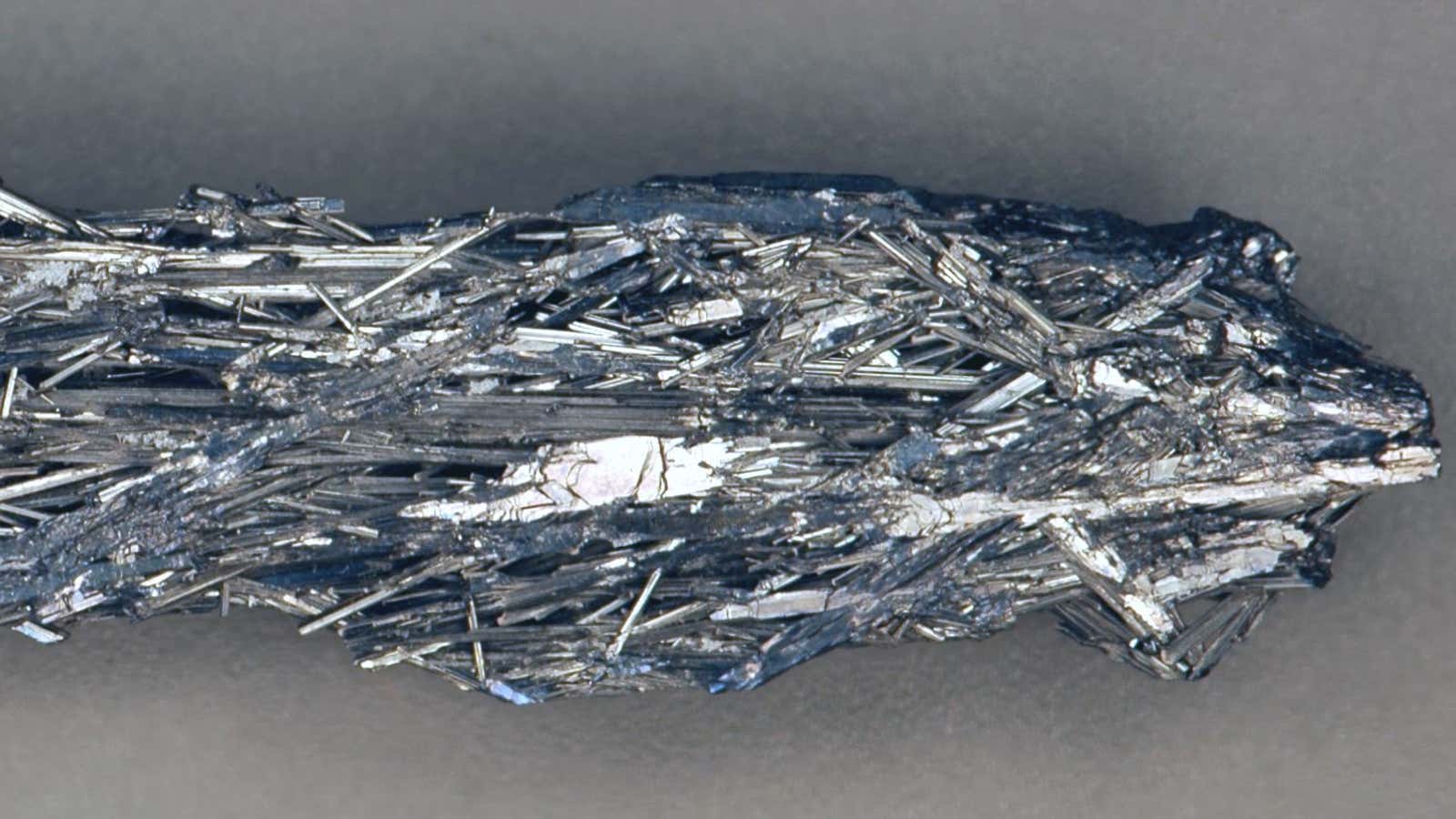This post has been corrected.
China’s volatile stock markets aren’t the only places where retail investors are losing huge amounts of money these days. Thousands of investors may be out billions of dollars after investing in a Chinese company that grew to become the world’s largest rare metals trading exchange in just four years.
Earlier today (July 16), nearly 200 investors in Shanghai gathered to demand their money back from officials at Fanya Metal Exchange, a trading platform-turned-asset manager that counts China’s biggest banks and metals companies among its partners. They join the 800 or so people who demonstrated outside Fanya’s Kunming headquarters on July 13, outraged that for months they’ve been unable to access billions of yuan (link in Chinese) worth of investments, reports Metal Bulletin (paywall).

At issue is an investment called Ri Jin Bao, a financial product guaranteed by Fanya that promises retail investors annualized returns as high as 13.7%, and the right to withdraw funds at any time. Those funds have been frozen since April, when Fanya said it ran into “liquidity problems,” according to Caixin (link in Chinese). A reported 40 billion yuan ($6.4 billion) owed to 220,000 investors nationwide has been frozen.
“I think Fanya breached a unilateral contract when selling Ri Jin Bao,” one of the protesting investors told Metal Bulletin. ”It’s unfair for us.”
Why did hundreds of thousands of individual investors sink millions of yuan into a derivative product linked to indium, bismuth, and other metals few have ever heard of? The answer highlights how Chinese government regulations make it hard for middle-class households to safely grow their savings. It also reveals how easily China’s out-of-control borrowing creates wealth from nothing—and how quickly that wealth can collapse.
Betting the farm on bismuth
Chinese middle-class households have long been in a tough spot. To subsidize its investment-driven economy, the Chinese government sets the savings deposit rate artificially low. It also all but bars individuals from investing outside of China, leaving local property and stocks as the most obvious ways of growing their wealth.
Investors looking for alternatives to these crowded and incredibly volatile markets throw their cash into everything from pu’er tea to liquor—and, evidently, indium, bismuth, and other “minor metals” that Fanya specialized in.
Major money for minor metals
The “minor” moniker is in part because these metals are usually the byproduct of extracting other, more commonly traded metals. Indium, for instance, is left behind from processing zinc and lead. More commonly traded minor metals are used in a range of niche technologies—everything from LCD screens and solar panels to makeup and pharmaceuticals. These two factors make them a tricky industry to understand, says Anthony Lipmann, owner of Lipmann Walton & Co, a London-based metals trading firm.
“It is a market for trade parties, people like us who spend a lifetime to understand where metals such as rhenium, zirconium, hafnium—or Fanya-listed items such as bismuth, antimony, indium, cadmium, etc.—arise and are used,” he tells Quartz via email. “They are not suitable vehicles for investment by widows and orphans.”
Another reason Fanya’s exchange struck industry insiders as an odd investment is another defining feature of minor metals: they trade in relatively low volumes globally.
In theory, metal-trading exchanges allow traders to hedge risk via a forward delivery system, at the same time creating reliable reference prices. Not so with the metals Fanya was dealing in.
“Minor metals are too small in volume to be liquid enough for an exchange,” Lipmann says in his email. “Indium, which was listed on Fanya, is a market of about 1,500 metric tons [1,650 tons] per year supply/demand. Copper, which is listed on the London Metal Exchange, is a market of about 22 million [metric] tons per year.”
Fanya’s mysterious premium
Strangely though, Fanya consistently offered double-digit premiums over prices offered on the Chinese spot market. This became particularly salient after the global financial crisis, when demand for solar applications using indium slowed.
The rise of Fanya appears to have affected prices to the degree that it “became an alternative source of demand for metal that otherwise would largely have been used in high-tech applications,” says Alex Harrison, editor of Metal Bulletin. “Some producers preferred to deliver to Fanya at its prices rather than the levels prevailing in the spot market. In effect producers used the price but consumers didn’t, sticking instead to formulas tied to reporting agencies’ prices.”
Creating money from nothing
This premium is probably thanks, indirectly, to the cash rushing in from retail investors. In 2013, this is how Fanya explained that premium to Metal Bulletin (paywall): ”Traditional spot market prices are determined by supply and demand. Fanya’s pricing rule is: supply and demand plus capital.”
Fanya declined to elaborate on where that “capital” came from (and didn’t return Quartz’s request for comment). It seems likely it refers to the exchange’s selling of financial products, like Ri Jin Bao, linked to the metals traded.
Retail investors aren’t the only ones who profited from Fanya’s scheme. The platform allowed producers to buy and sell simultaneously, according to Metal Bulletin—effectively letting suppliers create their own demand.
This setup did more than just allow canny producers to pocket the difference between the spot price and Fanya’s premium. In the time between the sale to the exchange and the repurchase of that same pile of indium, they could use a warrant guaranteeing their right to buy that indium back in the future as collateral for short-term bank loans.
Shaking up global supply
Using this model, Fanya rose from relative obscurity to become by 2014 the dominant platform, by turnover, for trading metals like iridium—but not without attracting criticism around the world. As Christopher Ecclestone, mining strategist at boutique investment bank Hallgarten & Co., wrote last year:
Originally we had heard that this was going to be a market for trade players. However it would appear that in true Chinese fashion it has morphed into a playground for the notorious Chinese penchant for gambling.
A Chinese government regulator warned online late last year that the exchange was a high-risk investment. But that warning was quickly removed from the regulator’s website. Recent posts on Chinese social media about the Kunming protest and speculation about whether Fanya was still allowed to trade are being quickly removed by China’s censors.
On July 15, in response to the initial protests, Fanya said it would buy back (link in Chinese) 5 billion yuan of metals from investors, using money from its producer partners. But in its announcement, Fanya put the blame firmly on a new favorite scapegoat in China’s topsy-turvy markets, rather than its own highly unusual business model. “Malicious foreign devils” were to blame for “speculating on falls in China’s minor metals prices,” as well as for “slandering” the company, and destroying value for everyone else, according to Fanya’s statement.
It’s not clear what Fanya is referring to, because its licensed traders are almost all domestic. What’s more likely is that the relationship will flow the other way—that Fanya’s distortion of supply and demand might affect global prices.
“Six years’ worth of indium is currently sitting in the Fanya warehouses or warehouses under their auspices,” says Metal Bulletin’s Harrison. ”If the exchange were to explode, what would happen to all this indium or bismuth?”
Zheping Huang contributed reporting. Lead image by Flickr user James St. John (image has been cropped).
Correction (August 4, 2015, 7:15 a.m. ET): An earlier version of this post misstated Anthony Lipmann’s position, implying he is current chairman of the Minor Metals Trade Association; he was chairman from 2003 to 2006.
